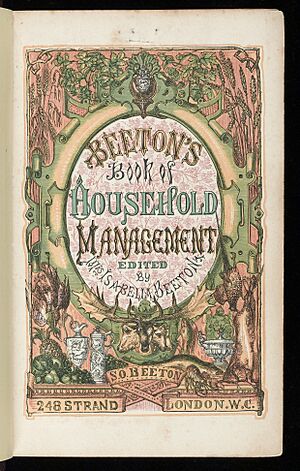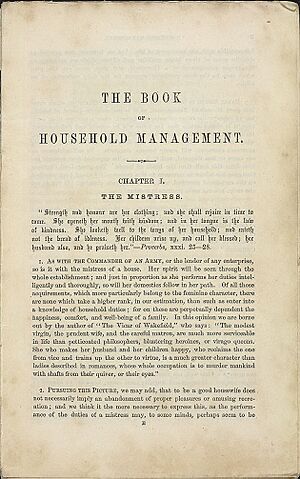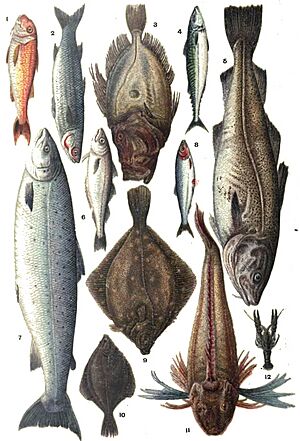Mrs. Beeton's Book of Household Management facts for kids

Title page: the first edition did not use the "Mrs." of later editions.
|
|
| Author | Isabella Beeton |
|---|---|
| Language | English |
| Subject | Cookery |
| Genre | Manual |
| Publisher | S. O. Beeton Publishing |
|
Publication date
|
1861 |
Mrs. Beeton's Book of Household Management is a super famous guide from Victorian Britain. It teaches you all about running a home, especially cooking! Isabella Beeton edited it, and it first came out as a book in 1861. Before that, it was published in smaller parts.
The book was special because its recipes were very organized. This was different from older cookbooks. It also had lots of pictures, both black and white and in color.
Even though Mrs. Beeton passed away in 1865, her book kept selling like crazy. Later versions even removed the notice about her death. This made readers think that an experienced Mrs. Beeton was still writing every word herself!
Many recipes in the book were actually copied from other popular cookbooks of the time. This practice is now called plagiarism.
The book grew bigger and bigger over the years. By 1907, it had 74 chapters and more than 2,000 pages! Almost two million copies were sold by 1868. Even today, you can still buy it. From 1875 to 1914, it was probably the most used cookbook around. Mrs. Beeton is often compared to modern "domestic goddesses" like Nigella Lawson and Delia Smith.
Contents
The Story Behind the Book
How it Started
The author, Isabella Beeton, was only 21 years old when she began working on this huge book. It first appeared in 24 monthly parts. These were published in her husband's magazine, The Englishwoman's Domestic Magazine, starting in 1859.
On October 1, 1861, all the monthly parts were put together into one big book. Its full title was super long! It included information for everyone in a household. This meant the mistress, housekeeper, cook, and even the coachman and maid-of-all-work. It also had tips on health, medicine, and legal stuff.
Isabella's Goal
In the book's introduction, Isabella Beeton shared why she wrote it. She said she saw how much trouble and unhappiness came from homes that were not well-managed. She believed that badly cooked dinners and messy homes often made families unhappy. She wanted to help solve these problems.
Isabella's half-sister, Lucy Smiles, later remembered how the book was made. She said that different people gave their recipes for the book. Every recipe was tested to make sure it worked well. Their home was a place of many cooking experiments, and some failures too!
Huge Success
The book was an instant hit! It sold 60,000 copies in its first year. By 1868, nearly two million copies had been sold. In 2010, a first edition copy in great shape was worth more than £1,000. A new version was released in 1863.
After Isabella's Death
Isabella Beeton died in 1865. A year later, her husband, Samuel, had money problems. To avoid going bankrupt, he sold the rights to all his publications. The rights to Household Management were sold to publishers Ward, Lock and Tyler for £3,250.
Early editions of the book included a notice about Isabella's death. But the publishers later removed it. This made readers think that "some mob-capped matriarch was out there still keeping an eye on them."
The book has been updated many times, even up to today. This has kept the Beeton name famous for over 125 years. However, today's versions are very different from the ones Mrs. Beeton worked on. By 1906, the book had 2,056 pages and 3,931 recipes. It was much bigger than earlier editions.
What You'd Find Inside
This section describes the 1907 edition, which was much larger than the first. The first edition had 44 chapters, but the 1907 one had 74 chapters and over 2,000 pages!
A Guide for the Home
The book starts with chapters about the duties of the "mistress" (the lady of the house), the housekeeper, and the cook. Then come chapters on the kitchen itself. There's a section on "marketing," which means choosing good quality food at the market. Chapter 6 is an introduction to cooking. These first few chapters take up more than 100 pages.
Chapters 7 to 38 (about 1000 pages!) cover English cooking. You'd find recipes for soups, gravies, fish, different meats (like veal, beef, mutton, lamb, and pork), poultry, and game. It also includes recipes for preserves, vegetables, pastries, puddings, sweets, jams, pickles, and savouries. Chapter 39 teaches the "art of carving at table," with eleven helpful pictures.
Chapters 40 to 50 (around 200 pages) give instructions for dairy products. There are also recipes for vegetarian and "invalid" (sick person) cooking. You can learn to make bread, biscuits, cakes, and different drinks.
Global Flavors and Household Tips
Chapters 51 to 59 describe cooking styles from around the world. These include French, German, Spanish, Jewish, Australian, South African, Indian, American, and Canadian recipes.
Chapters 60 to 68 guide you on many household matters. This includes how to truss poultry (tie it up for cooking) and definitions of cooking terms. It also covers arranging meals, decorating the table, making menus, and the duties of house servants.
Chapters 69 to 73 describe "household recipes" for things like cleaning. They also include medical preparations. The very last chapter, 74, offers "legal memoranda," which are legal notes.
The book has a very detailed index to help you find things. It also included advertisements for products like beef extract and cocoa.
How Recipes Are Organized
Mrs. Beeton wanted to make sure that men had such good food at home that they wouldn't need to eat out. She aimed to make cooking basics easy to understand for any "housewife."
She explained that she tried to make every recipe clear. Each one had a list of ingredients, simple steps for how to prepare the dish, and an estimate of its cost. It also told you the number of people it would feed and when it was seasonable (the best time of year to make it).
The book also gave advice on being a good homemaker. It suggested waking up early, keeping things clean, being careful with money, and having a good temper. It also advised interviewing servants instead of just relying on written references.
The book talks about how cooking has changed over time. It mentions that people used to eat roots and fruits. Then they became hunters, fishers, and farmers. It says that even though we still eat the same basic foods, our cooking skills make them much more enjoyable.
Each recipe has a title and a list of ingredients with amounts. The instructions are called "Mode." For example, it might say, "Cut up the veal, and put it with the bones." There's also a section for the total preparation time and the average cost. Many recipes also tell you when they are "seasonable" and how many people they will feed. Finally, a "note" gives extra advice, like "When stronger stock is desired, double the quantity of veal." This very organized way of presenting recipes was a big new idea for its time.
Interesting Facts
Even though the book was meant to be a reliable guide for running a home, the first edition spent only 23 pages on household management. Almost all the other 900 pages were about cooking!
Some of her cooking advice seems a bit strange today. For example, the book suggests boiling pasta for an hour and forty-five minutes! Also, like many British people of her time, Mrs. Beeton didn't like unfamiliar foods. She said mangoes tasted like turpentine, lobsters were hard to digest, and garlic smelled bad. She even called potatoes "suspicious" and said tomatoes were sometimes good, sometimes bad.
Unlike older cookbook writers, Mrs. Beeton's book focused on saving money. It also changed the way recipes were written. Older books had long, confusing paragraphs with ingredients and steps all mixed up. Mrs. Beeton's book used a modern, easy-to-use format. It listed ingredients, method, timings, and even the estimated cost for each recipe.
Pictures in the Book
The 1907 edition had about 30 full-page color pictures and over 100 full-page black and white illustrations. These included photos, like one of a housekeeper in her kitchen.
You can see how much detail was included. For example, there were eleven pictures of different types of fish. One full-page color picture showed various puddings, like jelly, raspberry cream, and a trifle. Another color picture showed different fruits piled high on dishes.
Images for kids
Influence and Legacy
How it Influenced Others
Mrs. Beeton's Book of Household Management became very famous. In Australia, a cookbook called Queensland Cookery and Poultry Book (1878) mentioned it. The author said her book was for people who couldn't afford a "Mrs. Beeton."
By the 1890s, the name "Beeton" became a term for someone who knew everything about home and cooking. The Robert Mondavi Institute for Wine and Food Science said it was probably in more homes than any other cookbook. It was likely the most used cookbook between 1875 and 1914.
Even in fiction, Mrs. Beeton was famous. In Sir Arthur Conan Doyle's novel A Duet, with an Occasional Chorus (1899), a character says, "Mrs. Beeton must have been the finest housekeeper in the world, therefore Mr. Beeton must have been the happiest and most comfortable man."
Modern Connections
Mrs. Beeton has been called "the grandmother of modern domestic goddesses." This refers to chefs like Nigella Lawson and Delia Smith. Like Beeton, they saw the need to give helpful cooking advice to British middle-class families. However, Lawson and Smith say cooking is easy and fun. Beeton, on the other hand, showed that good cooking takes hard work and skill.
A food writer and chef named Gerard Baker tested and updated 220 of Beeton's recipes. He published them in a book called Mrs. Beeton: How To Cook (2011).
In 2011, for the book's 150th anniversary, the Royal Society of Chemistry wanted to feature one of Beeton's recipes. Because of money problems at the time, they chose her toast sandwich. This was a very simple dish that Beeton included for people who had less money.
In 2012, a food expert for the British TV show Downton Abbey said Beeton's book was an "important guide" for the food shown in the series.
In a 2019 episode of Good Omens, a Victorian-style book is used as a prop. It looks like the thick, 2,000-page version of Mrs. Beeton's Book of Household Management.
Editions
The book has been published in many different versions over the years. It first came out in monthly parts from 1859 to 1861, then as a bound book in 1861. Many new editions were released by different publishers, especially Ward, Lock and Tyler, throughout the late 1800s and 1900s. It continues to be reprinted even today.









